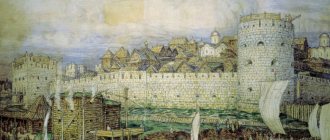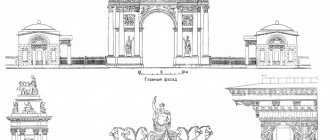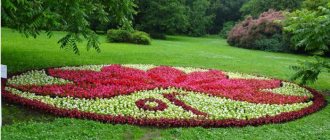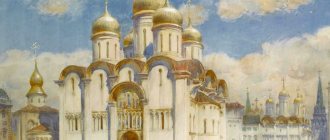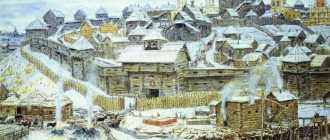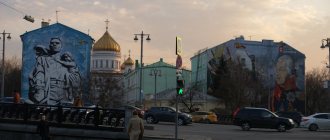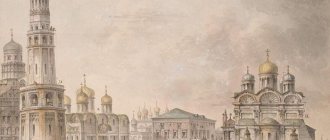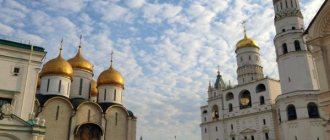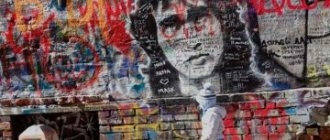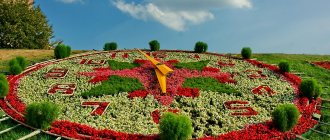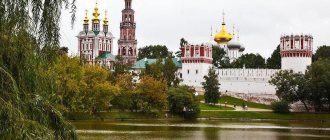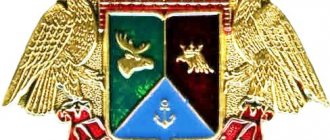- Reports and messages
- Geography
- Moscow
Moscow is the capital of the Russian Federation. It was formed in ancient times, every year it expanded and was built. Today, Moscow is the largest and most beautiful city, which in one day, coming on an excursion, cannot be seen and all the sights cannot be seen. It is famous for its beautiful parks, a large number of beautiful architectural buildings, temples and churches, and monuments.
Kremlin
In the center of Moscow is the Kremlin, it is built of red brick with numerous towers and buildings. On the central tower called Spasskaya, there is a large clock. In its interior there are churches, museums, parks, monuments, and the building where Vladimir Vladimirovich Putin, the Governor of the Russian Federation, works. In ancient times, the Kremlin was built of ordinary stone, and because of this Moscow had the name white stone, modern, it was restored, and now it is built of red brick.
Tsar Bell and Tsar Cannon
They are located on the Red Square itself. This name was given to them because of their enormous size. They are located nearby. But it is impossible to ring the bell, because when it was cast, it split, and to this day it stands as if inactive, like a monument, and the broken piece lies nearby. And the cannon, due to the fact that it has not been used for a long time, still stands as an architectural monument.
St. Basil's Cathedral or Intercession Cathedral
It is one of the huge and incredibly beautiful churches in Moscow. It is also located on the territory of the Kremlin. This cathedral has quite beautiful multi-colored domes, and each of them has individual paintings, and the temple itself has many windows and arches. Inside the temple there are painted walls.
Ostankino Tower
Of course, today, in every house and apartment, there is a TV with a modern channel supply. And the Ostankino TV tower, to this day, continues to distribute the signal of numerous television programs over long distances. Inside it there are offices of TV channels and radio stations. The TV Tower is the tallest building in the whole world. If you wish, you can visit it, and along the way you can go to the restaurant, which is located in the tower; it is located on the upper floors of the tower. The main attraction of the Ostankino TV Tower is the Seventh Heaven restaurant, which has a rotating floor, thanks to which you can watch the changing landscape outside the window.
Tretyakov Gallery
This is a gallery located in the city center, founded by Tretyakov. He had a special feeling for art, and for many years he collected various exhibits, and then presented his entire collected gallery to his city, so that anyone could easily see the beautiful painted paintings with their own eyes. All paintings were by Russian artists. Every day the exhibition is visited by more than a dozen visitors.
Tomb of the Unknown Soldier
Near the walls of the Kremlin in the garden there is a monument made of marble and bronze to the soldiers who gave their lives in battle for their country. The initials of the soldiers are unknown, but their memory is honored to this day. In front of the monument itself, in the center, an eternal flame burns, which does not go out even in bad weather. Every year a wreath-laying ceremony takes place at the grave.
Conclusion
To summarize, we can say that Moscow is very beautiful and huge, with numerous attractions. And therefore, at least once in your life you should visit Moscow on a tour, because the emotions you receive from what you see will be remembered for a lifetime.
When was the modern capital of Russia founded?
Until now, scientists have not reached a consensus on the age of Moscow. For the first time its name appears in the Ipatiev Chronicle (1147). According to legend, Moscow was founded by Prince Yuri Dolgoruky. A few years later, he fortified the city by erecting wooden walls.
As for the origin of the name “Moscow”, it should be noted that in the Middle Ages not only Slavic, but also Finno-Ugric tribes lived here. Most likely, it was from the vocabulary of the latter that the word “mosk” was taken, meaning something raw and viscous. Scientists explain this origin of the city’s name by the fact that in ancient times there was only a small swamp on the territory of the modern metropolis.
Climate in the city
The capital's climate is moderate. Seasonality is clearly expressed. In winter there are short frosts, during which the temperature drops below -20 degrees. There are often thaws in December. More than once December has been marked by rain on New Year's Eve. Summer, in turn, is famous for its high temperatures. Often exceeding the mark of plus 30, it forces city residents to seek shelter in park areas. July is considered the warmest month. Spring and autumn, in turn, delight residents with their moderation. Atmospheric precipitation, most of which falls in summer, reaches 800 mm per year.
Medieval history of Moscow: interesting facts
As mentioned earlier, the capital of Russia was founded at the beginning of the 12th century. Since then, many events have happened that will be interesting for both adults and children to know about. However, when telling stories to their child, parents should be sure that interesting facts about Moscow are accurate and scientifically proven.
So, it is now reliably known that Red Square appeared in the 15th century. Its occurrence is associated with the decree of Ivan III, who did not allow the construction of any structures near the Kremlin in order to prevent fires. This is how an empty space arose on the eastern side of the walls. It should be noted that initially it was called “fire”. Until the 17th century The square was built up on four sides. That's when it acquired its modern appearance.
Speaking about the Kremlin, it is important to note that it was originally built of white stone. The construction of Dmitry Donskoy began to be rebuilt under Ivan III. It was then that walls made of red burnt bricks were erected.
City's legends
There are other versions of the appearance of Moscow. A branch of works under the general title “The Legend of the Conception of Moscow and the Krutitsa Bishopric” appeared at the end of the 17th century. Here, the clearly fictional prince Daniil Ivanovich is looking for a place to found a royal city. In the forests he meets a spotted beast with three heads. The prince's adviser, the Greek Vasily, interprets this meeting as a sign: the kingdom will be triangular, inhabited by a variety of people. On the territory of the future city, two points are identified: the island where the hermit Bukal lives becomes the site of the royal court (fortress), and the hill where a certain Roman Podon lives becomes the site for the Krutitsky monastery. The city was founded in 6720 (1212) [5].
Although the “Tale” contains a lot of fiction, a historical grain is also present in it: the creation of the Krutitsy metochion is attributed to Prince Daniil of Moscow precisely in the 13th century.
But this “box” of Moscow legends does not end there! There is also “The Legend of the Founding of Moscow by Oleg,” or “The Beginning of the Reigning City of Moscow,” which researchers also date back to the second half of the 17th century. In it, the governor of Rurik, Prince Oleg, is declared the founder of Moscow, and the event itself is dated to the year 6388 (880). After Oleg, Igor Rurikovich became the prince of all Russian lands. The narrative, compressed to the limit, literally emphasizes a very important point (for the establishment of princely power): the unknown author notes that Igor descends from the “Caesar of Rome” Augustus [5]. Thus, there is no longer even a need for the formula: Russia is actually called the heir of Rome.
Pre-revolutionary Moscow
When telling interesting facts about Moscow for schoolchildren, it is important to mention the pre-revolutionary period, when the city was very different from the modern metropolis.
- Until the 18th century Chistye Prudy had a completely different name - Poganye. This was due to the fact that garbage and waste were dumped here. After the pond became part of Menshikov’s estate, it was cleaned and given a new name, which has been preserved to this day.
- During the Napoleonic Wars in 1812, Moscow was burned. Most of the city's buildings were damaged. Their restoration and reconstruction took more than 30 years.
- The water pipeline in Moscow was built only in the first years of the 19th century.
- In 1872, the capital's telegraph began operating.
- In 1898, a sewer system appeared.
- In 1901, the first elevator began operating in Moscow.
- The founder of Moscow State University is M.V. Lomonosov, who never visited it.
Moscow is the capital of a unified state
During the reign of Grand Duke Ivan III (1462-1505), Moscow was already the capital of the Russian state. The lands of North-Eastern Rus' were finally freed from the yoke of the Horde, the Moscow State gained independence, and Ivan III made every effort to turn Moscow into the “Third Rome”. After Ivan III married the niece of the last Emperor of Constantinople, Sophia Paleologus, the Byzantine double-headed eagle became the symbol of the Moscow autocrat. His images appear on princely seals.
In the process of strengthening the Russian state, much attention was paid in Moscow to the construction, in particular, of the Kremlin fortifications and churches. It was at this time that the square, now known as Red Square, began to take shape. Until the 16th century it was called Torg, later it received the name Trinity, after a fire raged here in 1571 - the square began to be called Pozhar, and only in the mid-17th century the square acquired its current name.
In order to justify the title of successor to Byzantium, the main Orthodox state, the Russian Orthodox Church began to carry out active activities to strengthen the religious faith among the people. Russian princes who fought against the invaders, ascetics and statesmen were glorified and canonized. Consistent and competent actions of the Moscow princes aimed at “gathering Rus'” led to the fact that the Moscow principality took possession of 70 volosts and 25 cities, which were located in the upper reaches of the Oka, Desna and its tributaries, as well as the Dnieper. Among other cities were: Chernigov, Bryansk, Putivl, Rylsk, Smolensk. The conquest of Smolensk in 1514 was an important milestone in strengthening the western cordons of the Russian state.
The 15th century was marked by the transformation of Moscow into a major cultural center. At the beginning of the 15th century in Moscow, the greatest Russian icon painter Andrei Rublev lived and worked in one of the monasteries; the best books of that period were handwritten here.
Interesting facts about Moscow during World War II
- In 1941, the Kremlin, like many other sights of the capital, was camouflaged. Already on the day war was declared, a Wehrmacht plane appeared over the city. The Germans managed to take many photographs and create an accurate map of the capital of the USSR. This led to an urgent need to change the Kremlin beyond recognition. Whole detachments of artists and architects, led by B. Iofan, were sent here. As a result, at the end of June the Kremlin looked like an ordinary residential area. The golden domes were hidden, the towers were repainted, and models of houses appeared on the square and slopes.
- An important event during the Second World War was the Battle of Moscow. Not only adults, but also schoolchildren need to know interesting facts about the course of military operations. More than 7 million people took part in this battle. This exceeds the number of people involved in the Berlin operation. It is also important to know that the blitzkrieg (the German plan for a rapid offensive and capture of the entire territory of the USSR) was thwarted precisely during the battle for Moscow.
The first Russian Tsar Ivan the Terrible and his followers
A fateful event for the Russian state was the coronation of the first Russian Tsar, who became the young Moscow prince Ivan IV (the Terrible). This event took place in 1547. The head of the Russian church, Metropolitan Macarius, placed the Monomakh cap on the head of Ivan IV and officially proclaimed him a Russian autocrat. However, in 1561, a letter came from the Ecumenical Patriarch of Constantinople Joseph signed by 37 hierarchs of the Eastern Orthodox Church, which stated that they bless Ivan IV for the reign, however, what was done by Metropolitan Macarius cannot be considered legal, because only the Roman and Constantinople high priests have the right crown kings. This letter offended the Russians. Russia was at the moment a free state, the direct heir of the Byzantine Empire, and she had to seek permission from the patriarch, who himself was not independent, but needed recognition of his rank as a Turkish ruler.
After the death of Ivan the Terrible, the rulers of Moscow are doing everything possible to ensure that Russia has its own high priest - the highest church hierarch who will help make tsarist power universally recognized. As a result, in 1589, Patriarch Jeremiah and his retinue arrived from Constantinople to Moscow, and together with the Holy Council (bishops of the Russian Church) elevated Metropolitan Job to the throne of All-Russian Patriarch. Thus, the Russian Orthodox Church became autocephalous - an independent church.
The time of the “Great Troubles”, which came after the death of Boris Godunov, marked the beginning of the 17th century. Moscow rulers were replaced one after another, and the city itself was in the power of the Poles. The inspirer of spiritual resistance to the invaders was Patriarch Hermogenes, who announced that if the prince Vladislav Sigismundovich (Zhigimondovich) did not accept Christianity, renouncing Catholicism, then he would not rule in Moscow. This condition was impossible to fulfill, since the prince’s father, Sigismund III, was a fanatical Catholic and opposed his son changing his faith. Then the patriarch began sending letters to various Russian cities calling for the liberation of Moscow. The people's militia was headed by Prince Dmitry Pozharsky, a talented military leader with an unblemished reputation, and the people's elder Kozma Minin. Prince Pozharsky led the militia to Moscow in August 1612, and Moscow was completely liberated only in October. In honor of this significant event, in 1818 a monument to the liberators of Moscow “Citizen Minin and Prince Pozharsky” was erected on Red Square.
Interesting things about Soviet Moscow
Looking at the Soviet period, you can learn some very interesting facts about Moscow:
- During the existence of the USSR, the city's territory increased more than 5 times.
- Moscow was proclaimed the capital of the Soviet Union in 1922.
- The famous soda from a machine in the capital cost only 1 kopeck, and if with the addition of syrup - 3. Despite the fact that there was an acute shortage in the country, the cups were never stolen, but were rinsed in the fountain and returned to their place.
- The construction of the Moscow metro began in the 30s, although the first projects arose even before the October Revolution. It should be noted that today almost every station has been renamed more than once. At the initial stage of the metro’s existence, there were stops with interesting names: “Kolkhoznaya” (now “Sukharevskaya”), “Mir” (now “Alekseevskaya”).
- New issues of newspapers were published twice a day, and they were immediately delivered to mailboxes. Information about all events could also be obtained from special street stands.
Popular message topics
- Preparing for the
All-Russian test, this is, of course, not an exam and you shouldn’t be afraid of it. VPRs are carried out solely to monitor the level of knowledge in schools. - Predators and their prey
Animals and birds that feed on the meat of other animals or their own kind are called predators or carnivores. Currently, this category is conventionally divided into two main species - land animals and pinnipeds. There are about 300 species worldwide - Relict woodcutter (insect)
The relict woodcutter is a representative of arthropod insects from the order Coleoptera, belongs to the family of longhorned beetles and the genus of callipogons. The beetle has several other names, such as relict barbel, Ussuri barbel and Ussuri relic woodcutter.
Interesting about modern times
What interesting facts about modern Moscow can you tell children?
- The modern business district "Moscow City" emerged only in the early 2000s.
- The Kremlin is the largest European fortress that has survived to this day.
- The Victory Monument is the tallest monument in the capital.
- In 1994, a law was introduced, which is still in force today, prohibiting dogs from barking between 11 pm and 7 am. If the owners do not take care of their pet, they are fined.
- Moscow is home to the largest number of billionaires in the world. New York is in second place for these indicators.
- The tallest television tower in Europe is Ostankino, located in the capital of Russia.
Finno-Ugric theory
Finno-Ugric peoples inhabited the territory of modern Moscow for a long time. Their language has the same word as in Slavic - “mosk”. But among the Finns and Ugrians it means not “river”, but “cow”.
According to the theory of some historians, the Finno-Ugric peoples named the area Moscow because the meadows and fields around the river were a good place for grazing livestock. This word translates as "cow river".
Interesting facts about nature and art in Moscow
Parents, when telling interesting facts about Moscow to children, should not miss information about natural resources and cultural development in the city:
- The largest zoo in Russia is located in the capital. It was founded in the 19th century.
- In Moscow you can find a huge number of parks. The Alexander Garden is considered the oldest.
- The Russian State Library, located in Moscow, is second only to the Washington National Library of Congress in its collection of books.
- The oldest clock in the city is the Kremlin chimes.
- There are about five thousand museums in Moscow. But, unfortunately, they most often open their doors to guests of the capital, and not to local residents.
- The oldest city building that has survived to this day is the Assumption Cathedral.
From 1712 to 1918, Moscow was deprived of its capital status, as St. Petersburg filled this role.
2. The city received its name in honor of the river of the same name flowing through it. And she, in turn, has two versions of the origin of the name. According to one version, it comes from the Finnish “mosk” - bear and “va” - water, and according to the second version, from the ancient Slavic “moskva” meaning “dampness” or “wet”.
3. The exact age of Moscow is not known for certain, so the countdown dates back to 1147, when it was first mentioned in the Ipatiev Chronicle. Long before the founding of Moscow, ancient settlements of Finno-Ugric tribes were located on its territory.
4. Until the 16th century, even the richest Moscow houses did not have glass. Instead, mica plates or fish bladders were used.
5. Moscow exceeded one million people living in it at the end of the 19th century. Now the Russian capital ranks first in Europe in terms of population. More people live here than in all the Baltic countries combined.
6. In 1910 there were 606 restaurants and taverns in Moscow; 933 taverns, snack bars, tea houses, coffee shops; 25 buffets and 905 beer shops and wineries.
MOSCOW METRO
7. The Moscow metro is one of the deepest and most beautiful in the world. Every day, 10 thousand trains carry 9 million passengers, which is the highest figure in the world. If you take the metro towards the center, stations will be announced in a male voice, and from the center - in a female voice; when moving along the ring line clockwise - in a male voice, counterclockwise - in a female voice.
8. There are actually four abandoned stations in the Moscow metro: Volokolamskaya (between Tushinskaya and Shchukinskaya), Sovetskaya (between Teatralnaya and Tverskaya), Pervomaiskaya (between Partizanskaya and Izmailovskaya " - not to be confused with modern ones of the same name), "Kaluzhskaya" (between "Novye Cheryomushki" and modern "Kaluzhskaya"). Traces of these stations - pillars and even vestibules - can be seen if you peer into the darkness while moving along the stretch.
9. Since 1938, the sculpture “Border Guard with a Dog” at the Ploshchad Revolyutsii metro station has been an object of worship for passengers. Even in the hustle and bustle, many people do not forget to rub the dog’s nose. At first it was fun for students: if you rub your nose, you pass a test, if you rub your paw, you get an exam. Everyone has long forgotten about this, and a dog’s nose has simply become a harbinger of good luck.
10. In 1812, during a fire that started as Napoleon’s army approached, about 80% of all buildings in Moscow burned down.
KREMLIN
11. Located in Moscow, the Kremlin is the largest active fortress in Europe.
12. The Moscow Kremlin is considered one of the largest museums in the world. The oldest part of the city occupies 27 hectares and amazes with the beauty of its towers, cathedrals and palaces.
CITY LIGHTS
13. The first 10 electric lamps in Moscow were lit on the towers of the Kremlin and Lefortovo Palace in 1856 on the days of the coronation of Alexander II.
14. Moscow has 72 theaters, 31 concert halls, many museums and historical buildings. Foreign tourists have a lot to see here!
15. The population density here is very high. It is comparable to that of Manila, the Philippine capital. The area of Moscow is approximately equal to the area of New York.
ASSUMPTION CATHEDRAL
16. There are 837 Orthodox churches and chapels in Moscow. The Assumption Cathedral is the oldest building in Moscow (1475-1479), which has survived to this day.
17. Every day, public transport in Moscow transports about 12 million people. This is roughly equal to the population of the entire city, but many people come here to work from the suburbs.
18. In 1904, a rare natural phenomenon in these parts was observed here - a tornado. It destroyed many houses and literally sucked water out of the Moscow River, exposing its bottom.
19. Since 1994, a government decree has been in force in Moscow, according to which dogs are prohibited from barking from 23-00 to 7-00. Owners who do not take measures to keep their pets quiet face a fine.
20. There is a museum of vintage cars in Moscow. It is located in the Lomakov Museum on Krasnodarskaya Street in Lyublino.
ALEXANDROVSKY PARK
21. Moscow surpasses many cities in the world in the number of parks. The oldest of them, the Alexander Garden, was built in the 18th century.
22. There are wild moose in Moscow parks.
23. Along with traditional monuments to Pushkin, Lermontov and many other worthy people, there are also unusual, outlandish monuments in Moscow.
24. This is: the monument to the stool on Taganskaya Street; processed cheese “Druzhba” at the intersection of Rustaveli Street and Ogorodny Prospekt; monument to a janitor at the intersection of Bazhov and Malakhitova streets.
25. In Moscow there is a sculpture for a student. It was installed in honor of the 110th enrollment of students. This sculpture stands at the entrance to the MIIT building.
ETHYYAVLENSKY CATHEDRAL CATHEDRAL
26. Epiphany Cathedral (Elokhovskaya Church) is the only one in Moscow that has an elevator. It was made for Patriarch Pimen. The height of this elevator shaft is 21 meters.
27. The expression “bird's milk” for a long time meant something unheard of, the limit of desire. Until in 1975, the confectioner of the Prague restaurant on Arbat, V. M. Guralnik, came up with a recipe for a new cake, which he gave the name “Bird's Milk”. Muscovites liked it so much that they “hunted” for it, stood in huge queues, and invited guests to see it.
28. If you add up all the streets of the city, their length will be about 4350 kilometers. A pedestrian walking at a speed of 5 kilometers per hour without stopping would take more than a month to cover this distance.
29. The oldest trees in Moscow are ancient oaks in Kolomensky Park, they are more than 7 centuries old.
30. At Yakimanskaya embankment, house 4, building 1, a mark about the flood of 1908 has been preserved. The sign hangs on the corner of the house at a height of 2 meters above the embankment level. In April 1908, boatmen carried residents through the streets and between houses.
31. Moscow is home to the largest zoo in Russia. Here you can see more than 550 species of animals from all over the world.
32. Tram is a very old type of Moscow public transport; the first electric line opened here back in 1899.
33. Some tram stops in Moscow are very old. One pre-revolutionary pavilion is still located in Krasnostudenchesky Proezd near the Dubki Park.
34.Tram No. 3 is the oldest route in the capital. Now it runs from Chistye Prudy to Balaklava Avenue.
35. Moscow is the first in the development of higher education for women. Its beginning is associated with the opening of the Moscow Higher Women's Courses by Professor V.I. Guerrier in 1872. Now it is the Moscow State Pedagogical University.
36. The Kremlin chimes are the oldest clock in Russia, they are about 5 centuries old. Their weight reaches 25 tons. The diameter of the chimes dial is 9 meters, the length of the minute hand is more than 4 meters, and the weight is about 50 kilograms.
37.The famous stars on the Kremlin towers were installed only in 1937, on the 20th anniversary of the revolution.
38. Since 1980, the “Lights of Moscow” museum has been operating in Armenian Lane, dedicated to the history of city lighting. Antique lamps, lanterns, photographs and drawings of various types of lighting devices - there is so much collected here!
39. The Lefortovo lantern can definitely be found here. There are also master classes organized by the museum, such as “The History of Fireworks” and “Ballroom Noble Traditions of the 18th Century”.
40. The tallest television tower in Europe is Ostankino, and in terms of the height of buildings it is in 8th place in the world. The height of the tower is 540 meters.
HISTORICAL MUSEUM
41. There are about 450 museums in Moscow. In terms of their collection of works of art, they can compete with the most famous collections in the world.
42. Muscovites began celebrating City Day in 1947, when Moscow turned 800 years old. Then it was decided that the first Saturday of September is a holiday for all residents of the capital.
43. The world's largest clock, barometer and thermometer are located here. They can be seen on the Moscow State University building.
MSU HIGH-RISES
44. You can get to the Arctic Ocean from Moscow by river transport.
45. In Moscow, near the 35 mm cinema, there is an anchor. There is a simple explanation for this: in Soviet times, the cinema was called “Novorossiysk”, and the anchor (as a symbol of the city) was specially brought from the Black Sea Fleet.
RUSSIAN STATE LIBRARY
46. Located in Moscow, the Russian State Library is one of the largest libraries with more than 40 million books. In terms of book collection, it is second only to the National Library of Congress in Washington.
47. In total, there are more than 500 libraries in the capital. In terms of their number, Moscow is the absolute record holder.
48. Now, according to the Department of Consumer Market and Services, there are 3,500 restaurants and cafes in Moscow.
49. Only the fourth generation of people living in Moscow permanently can be considered native Muscovites, but only 2% are such. At the same time, every year the percentage of Russian residents becomes smaller.
50. You can admire the panorama of the Kremlin from the middle of the Bolshoy Kamenny Bridge.
photo from the Internet
A little about interesting people
Children will be interested to learn about famous people who were born or lived in Moscow:
- Aleksandrov A.V. is a famous composer. Born in Moscow. Known as the author of the USSR anthem.
- Akhmatova A. A. is a famous Russian poetess. She lived in Moscow since 1918. She was closely connected with this city, since her son was in one of the capital’s prisons.
- Bruce Y. V. is the most educated person in the country during the time of Peter I. He was the first to draw up an accurate map of the territory of the Russian Empire.
- Repin I.E. is a famous Russian painter. He moved to the capital at the age of 23.
These and many other people (among them are Paustovsky K. G., Ranevskaya F. G., Nekrasov N. A., Pasternak B. L., Mayakovsky V. V., Mendeleev D. I., Bulgakov M. A. ) created the history of the modern capital of Russia.
Opinion of residents of the Baltic Sea countries
Russian philologist and linguist Vladimir Toporov has been studying the culture of the Baltic people for a long time. The scientist argued that the territory of Moscow is located in the region of Baltic hydronymy. The name of the Moscow River has the root mask (mazg), which is translated from the Baltic dialect as swamp and mud.
Based on this, it can be argued that the name of Moscow means a muddy and winding river. But among experts, Toporov’s version caused heated debate. On the one hand, he is right, but the Moscow River winds only in the area of the Moscow Ring Road. They doubt that the huge city was named only because of a small area of a reservoir.
